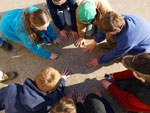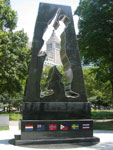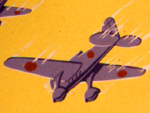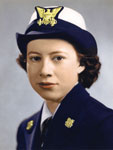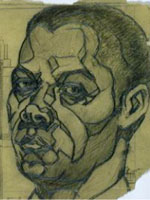Five years ago, during my first year of teaching Advanced Placement U.S. History in Leesburg, VA, I created a final exam for my students that I hoped would change the way they thought about monuments and memorials.
Preparation
For the students to fully execute this project, they first had to understand the purposes of monuments and memorials. We spent two days reading materials that discussed the goals of monuments and memorials. Students also read an article from the Washington Post Magazine that detailed a failed attempt to build a monument on the National Mall. The third day we watched History Channel videos on the presidential monuments and war memorials and critiqued the information that was presented on each. After our discussion on the videos was completed, I introduced the students to the final exam project.
The project was to create a 45-minute tour of a monument or memorial in Washington, DC. Each year, I pre-selected 15 monuments and memorials that were in walking distance of each other. I divided the students into groups of three or four and gave them five class days to plan the tours and accompanying brochures. Each tour and brochure had to explain the purpose of the monument and memorial and help visitors understand its role in history. Both the tour and the brochure had to use at least one primary as well as one secondary source for the information presented.
Throughout the year in my classroom, we had worked with primary and secondary sources, which prepared students to work with sources on their own for this project.
The students also had to create an activity that reinforced the information they presented to the audience. This activity had to be something that everyone could participate in and that incorporated the sources from the tour the group presented. I purposely did not give much guidance on the activities beyond emphasizing the need for primary and secondary sources. I wanted students to create their own activity that they believed helped to explain the monument or memorial to the group.
Sources
Throughout the year in my classroom, we had worked with primary and secondary sources, which prepared students to work with sources on their own for this project. To the students, primary and secondary sources are generally items that they use for research purposes—not incorporate into an active event like a tour—so this stretched their understanding of how to use sources and of how to create historical meaning.
I made sure that there were no duplicate groups and that students had plenty of resources available to use. Before assigning the project, I made a trip to the National Park Service Ranger Station in Washington, DC, to pick up brochures on individual monuments and memorials and a trip to my local library to take out books on the monuments and memorials. (It was near the end of the school year, so computer labs and the school library were in high demand).
The sources and books ranged from children's books and nonfiction sources to historical association publications. When the students were researching for their tours, I wanted them to have a mix of sources available so that they could create a unique tour.
I wanted the students to realize that primary and secondary sources of a historic site are not just the building plans but anything that deals with the site!
I researched each monument and memorial to make sure they had primary and secondary sources available that the students could find through the different National Park Service websites. I explained, though, that the primary and secondary sources did not have to be just about the monument and memorial—they could be from a spectator, newspaper, fundraising committee, or a schedule of opening day events. I wanted the students to realize that primary and secondary sources of a historic site are not just the building plans but anything that deals with the site!
When the students were researching, finding, and printing their sources, they analyzed sources in terms of usefulness for the tour and accessibility for the audience. Many found that the primary sources they selected allowed them to weave a story into their tour. I didn't have any guiding activities for their primary/secondary sources so the students had to analyze and synthesize the information on their own.
Plans Come to Fruition
I was nervous to let the students go like this, but I knew they had to do the analysis on their own to be able to speak intimately of the monument or memorial on their tour. The Vietnam Veterans Memorial group did this with ease. Although they were excellent students in my class, they had not been comfortable with primary source analysis in our previous in-class activities. The group began by searching for only primary sources dealing with the building of the monument, letters from veterans, legislation in Congress, and the plans from Maya Lin.
They were able to find a common thread between all the sources but they were still missing a piece that would connect the audience to the memorial personally.
I kept encouraging this group to look through the books I had checked out from the private library, but they were determined to sort through what they had found online and in journals in the school library. The group took the approach of observing the materials, seeing who wrote them, finding bias, and trying to connect the sources all together. They were able to find a common thread between all the sources but they were still missing a piece that would connect the audience to the memorial personally.
When the students finally started going through the public library material, they found a book that changed the focus of their tour. The book was Offerings at the Wall: Artifacts from the Vietnam Veterans Memorial. One student made a decision—she was going to let the offerings (primary sources left behind at the wall) take the lead. The group laid their sources out on a desk. They had photocopied offerings that they liked from the book and placed them with the other primary sources they had collected to construct a narrative for their tour. This was an extremely effective way to demonstrate the connection between the memorial and its visitors.
I collected the brochures the students created before we went on the field trip to Washington, DC. I did this for two reasons: one, so that I had time to grade the brochures, and two, so that the students could not rely on their brochures to present the tours. I didn't want them to just walk through the sites using their brochures; I wanted them to add to them with additional information that they had found through their research.
The day we left for the trip, the students came prepared with props, primary sources, handouts, and prizes for their activities. Each student received a response booklet that they were to fill out for each tour. My questions in the booklet aimed at what the students learned and the strengths and weaknesses that they saw. I had my own grading rubric to use and the chaperones who came with me were also assigned rubrics to grade with so that I could reference them later.
I had high expectations for the tours and the students knew this.
The first presentation was the hardest for the students but once one group went, the rest were relieved and couldn't wait to present. I had high expectations for the tours and the students knew this. My secondary goal of this project was to impart my passion for historical sites and discussing them to the students, and I could see that my passion had passed on to several of the students.
For each tour, every student had to talk for at least 15 minutes (for groups of three, or 11 minutes for groups of four) and had to draw on one source in his or her portion. The groups that brought pictures or documents to hold or pass around to the audience were usually the ones that the other students enjoyed most.
The best part for all of us was the activities that went along with each tour. The students really went above and beyond in planning activities to review what they talked about. Many of the groups found additional primary sources for this portion. They would either do a card sort where you mix and match the picture to a person or you would have to put pictures in chronological order based on the building of the monument or memorial. Several students also planned scavenger hunts around their monument or memorial.
The activities were usually based on the size of the monument and memorial.
The activities were usually based on the size of the monument and memorial. For example, the Washington Monument usually had a matching activity due to the limited access to the monument and the structure of it. The 56 Signers of the Declaration of Independence Memorial had a scavenger hunt based on the information on each plate since it was a smaller memorial with full access.
One memorial that invoked a lot of emotion for the students and for which students found primary sources easily is the National Japanese American Memorial to Patriotism During World War II by Union Station. This site is beautiful and the students really loved exposure to this piece of history. The site is dedicated to Japanese Americans' participation in World War II from military service to the internment camps.
The best tour site for a group of four was the Franklin D. Roosevelt Memorial, which is divided into four sections. The World War II Memorial was good for a larger group because I could divide the students into the Atlantic and Pacific fronts.
Having students base the tour on primary sources forced them to look in the past and find out about the monument or memorial as it was being built and presented to the public.
To talk for 45 minutes about a monument or memorial is not easy if you do not know the information well. Having students base the tour on primary sources forced them to look in the past and find out about the monument or memorial as it was being built and presented to the public.
My overall goal was to expose students to the resources and history that surround them. These students may or may not go back to these sites, but they will remember their stories and the stories monuments and memorials can tell. A few, I feel, will return and be able to tell the people they are with a little bit about what they are seeing.




